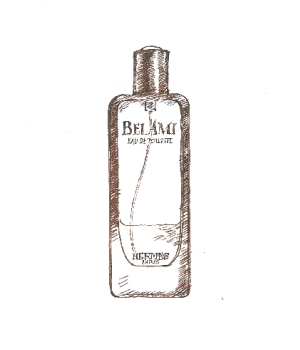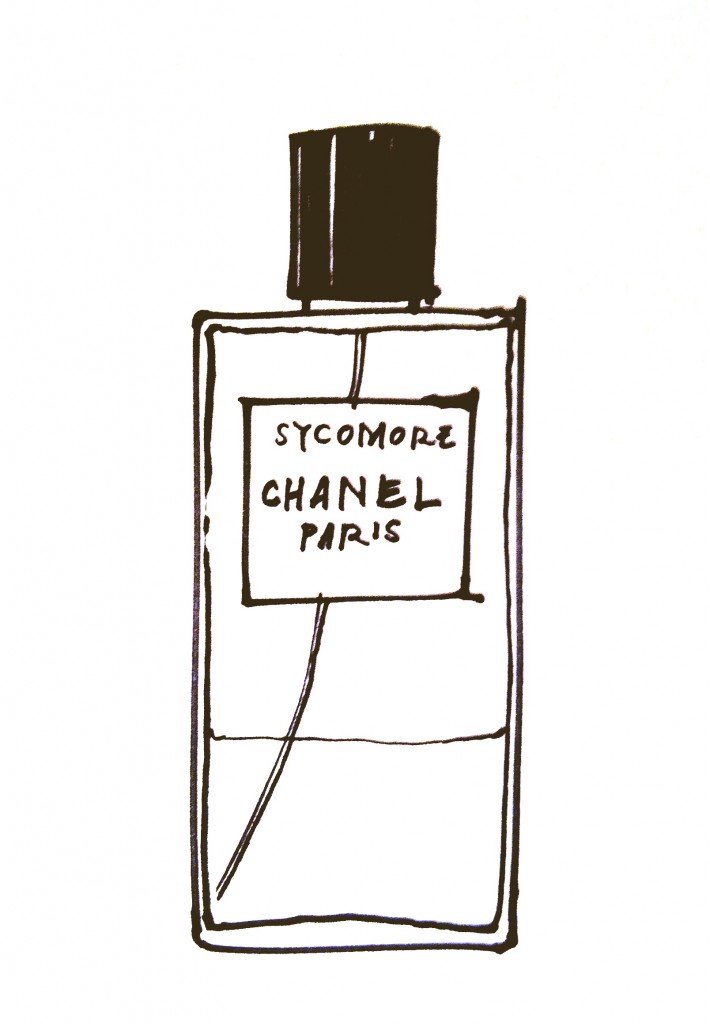Tagged With ‘masculine’
Hermès
Bel Ami
9 December, 2014
 I’ve been pondering furniture for my flat recently, and that has made me think about one of Hermès’ most famous perfumes, Bel Ami.
I’ve been pondering furniture for my flat recently, and that has made me think about one of Hermès’ most famous perfumes, Bel Ami.
Why? Well, it’s all about the difference between what, in the antiques trade, I guess you’d call original and repro. Bel Ami is a bit like a lovely Chippendale chest of drawers that once attracted admirers from all over the world – not just for the beauty of its design but for the skill and complexity of its construction.
The maestro in Bel Ami’s case was Jean-Louis Sieuzac, one of the finest perfumers of his time, who was also behind Fahrenheit for Christian Dior and Opium for Yves Saint Laurent. First launched in 1986, Sieuzac’s Bel Ami packed a powerful punch thanks to a combination of leather and pepper, and it was by all accounts a rich and complex scent.
But apparently it didn’t sell, and when Hermès appointed Jean-Claude Ellena as its in-house perfumer in 2004, one of his first jobs was to reformulate Bel Ami. This new version is still very attractive, with a schoolroom scent of pencil shavings that, after an hour or two, settles down into a pleasing, if not especially unusual fragrance of the kind that’s often described as ‘classically masculine’ – a bit wood-smoky without being bitter, slightly sweet without being at all cloying. It reminds me a lot of one of my other favourite ‘classically masculine’ perfumes, Halston Z-14.
What I wouldn’t describe it as would be particularly complex: it doesn’t change radically over the hours, though it does have good staying-power, and my amateur nose doesn’t detect lots of intriguing added ingredients, though I’m wondering if there’s a touch of clove-scented carnations. It is, in other words, a bit like a very good-quality piece of ‘repro’ antique furniture: looks pretty convincing on the outside, but when you open the drawers you realise they’re made of MDF instead of mahogany. A classy job nonetheless.
Chanel
Sycomore
28 May, 2014
 Until recently, Sycomore was one of the most extraordinary perfumes that I know (see note, below). OK, its name looks like a misspelling of sycamore, a tree that – in Britain at least – no right-minded person would name a fragrance after. Sycamores, after all, are as common as muck, breed like rabbits and are often looked down on by ecologists as they’re not even native trees.
Until recently, Sycomore was one of the most extraordinary perfumes that I know (see note, below). OK, its name looks like a misspelling of sycamore, a tree that – in Britain at least – no right-minded person would name a fragrance after. Sycamores, after all, are as common as muck, breed like rabbits and are often looked down on by ecologists as they’re not even native trees.
Acer pseudoplatanus, to give the tree its proper botanical name, is also responsible for many of those deeply irritating ‘leaves on the line’ excuses that railway companies give out each autumn to explain why their trains are running late. Worst of all, from a perfume perspective, they don’t even really smell of much, though their leaves do have the faintest leathery scent and their wood, once dried enough, burns with a pretty generic woodsmoke smell.
So is Sycomore just an example of misguided marketing, like Ralph Lauren’s dreadfully named Glamourous? Actually, no. Coming from arguably the world’s most tightly policed brand, its name will have been very carefully considered – and actually it almost certainly refers not, as I’d initially thought, to Acer pseudoplatanus at all but to a rather more exotic tree, the so-called Sycomore fig.
Ficus sycomorus (to use its Latin name) is a large, spreading tree that grows across central Africa and the Middle East, where its heavy shade is much appreciated; it was known to the Egyptians as the Tree of Life. It’s a tree I haven’t sniffed, but my guess is that it shares at least some of the dry, green, slightly fruity scent that we know from other varieties of fig – though ironically there’s only the faintest hint of figginess in Sycomore.
Anyhow, enough about the name. What makes Sycomore extraordinary, for me, is a trick it seems to be able to do that no other perfume I’ve come across seems to be able to do. This is to smell like two completely different scents, depending on whether you smell it close up or at a distance. Up close it has the strong, earthy, pleasantly bitter scent of vetiver, the root of an Indian grass that’s related to lemongrass and citronella. It’s also grown commercially in the Caribbean, and apparently Chanel’s super-high-quality vetiver originated in Haiti.
Vetiver is usually classed as one of the great masculine fragrances, presumably because of its bracing bitterness and lack of cloying sweetness; it’s certainly not a flowery smell. But it also has a warmth and – get this – a touch of smokiness that gives it extra depth and complexity, especially when it’s surrounded by such a delicious cushion of other scents, which mix smokiness with a slightly sweeter touch of fruit. Vetiver is also famous for its staying power, and a spritz of Sycomore can last you all day.
It’s the added fruitiness that, on occasion, one gets a whiff of when someone wearing Sycomore strolls by, and then it’s like a different, warmer, sweeter fragrance altogether, with hardly a hint of the vetiver that dominates the perfume on the skin. If it’s an intentional trick I’m in awe, though it seems perfectly possible, given that Sycomore was created by Chanel’s chief nose Jacques Polge in collaboration with Christopher Sheldrake, the legendary British perfumer who has been Chanel’s director of research and development since 2005.
Like the other fragrances that belong to Les Exclusifs de Chanel, Sycomore costs about twice as much as your average perfume, but it does come in a typically (for Chanel) handsome bottle, beautifully presented in a chunky white-and-black box. The hidden magnet in the heavy black cap, ensuring that the iconic twin Cs of the Chanel logo always end up perfectly aligned, is a particularly nice touch, even if it has since been adopted by one or two other brands.
Though it’s a classically masculine scent Sycomore is (quite rightly) marketed as a unisex fragrance, and like most men’s perfumes it can smell wonderful on a woman. Yet what I love most is that, from the very first sniff, it has a wonderful feeling of luxury, quality and depth, which are things that are all too often lacking in other perfumes. And who could resist its baffling cleverness, like a cryptic crossword in scent?
Autumn 2016 update. Oh dear: evidently Sycomore hasn’t been a commercial success, as Chanel have recently ‘updated’ it, and now – minus the fruitiness that made it so unusual – it’s a perfectly pleasant, fairly straight-up vetiver. From being unique it’s become one of many. Such a shame – another great perfume gone.
The job-interview fragrance
20 July, 2012
I was walking down Shaftesbury Avenue last week when I noticed, just ahead of me, a young woman standing outside the lobby of some fairly swanky offices. As I got closer, she reached into her handbag and produced one of those slimline canisters of scent, which she proceeded to spray all over herself like a crop duster until a cloud of foul-smelling perfume drifted across the entire street.
It was only at this point that it struck me how dressed- and made-up she was, and the thought crossed my mind that she must be going for an interview – in which case pity the poor interviewers. I spent the rest of the morning wondering what effect reeking of bad perfume might have on one’s chances.
If there’s a moral to the story (other than move fast if you ever see anyone getting a scent spray out of their bag), perhaps it’s that perfume, if it doesn’t exactly maketh the man, certainly maketh a bigger impression than one might imagine. I can’t imagine many blokes carry their favourite fragrance around with them, but choosing the right perfume for an important occasion is just as crucial for a man as for a woman. Get it wrong and you could ruin your chances.
Discretion may be the better part of valour, but it’s also a good guide when choosing a perfume for a job interview. The easy way out would be not to wear perfume at all, but wearing a really good but understated classic fragrance does wonders for one’s self-confidence – and can also make a good impression on other people, often without them even knowing why.
As far as fragrances go, it’s hard to beat something that embodies old-fashioned masculinity, such as Guerlain’s Vetiver. For something a bit warmer I’d choose Chanel’s Pour Monsieur, not least because it’s actually quite hard to overdo it. It’s a lovely discreet perfume, but if you’re feeling flush then the same company’s delicious, slightly lavendery Eau de Cologne is even finer – though as someone said to me the other day, ‘It’s a lovely cologne, but if I was going to spend that much money I’d buy something a bit more unusual.’
Fair enough – but surely it’s better to invest in a great fragrance than saving your money and smelling like fabric conditioner? Just remember that poor deluded girl on Shaftesbury Avenue. I wonder if she got the job?